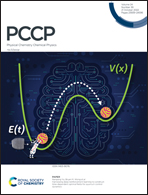Investigating the role of structural water on the electrochemical properties of α-V2O5 through density functional theory†
Abstract
The α polymorph of V2O5 is one of the few known cathodes capable of reversibly intercalating multivalent ions such as Mg, Ca, Zn and Al, but suffers from sluggish diffusion kinetics. The role of H2O within the electrolyte and between the layers of the structure in the form of a xerogel/aerogel structure, though, has been shown to lower diffusion barriers and lead to other improved electrochemical properties. This density functional theory study systematically investigates how and why the presence of structural H2O within α-V2O5 changes the resulting structure, voltage, and diffusion kinetics for the intercalation of Li, Na, Mg, Ca, Zn, and Al. We found that the coordination of H2O molecules with the ion leads to an improvement in voltage and energy density for all ions. This voltage increase was attributed to the extra host sites for electrons present with H2O, thus leading to a stronger ionization of the ion and a higher voltage. We also found that the increase in interlayer distance and a potential “charge shielding” effect drastically changes the electrostatic environment and the resulting diffusion kinetics. For Mg and Ca, this resulted in a decrease in diffusion barrier from 1.3 eV and 2.0 eV to 0.89 eV and 0.4 eV, respectively. We hope that our study motivates similar research regarding the role of water in both V2O5 xerogels/aerogels and other layered transition metal oxides.



 Please wait while we load your content...
Please wait while we load your content...